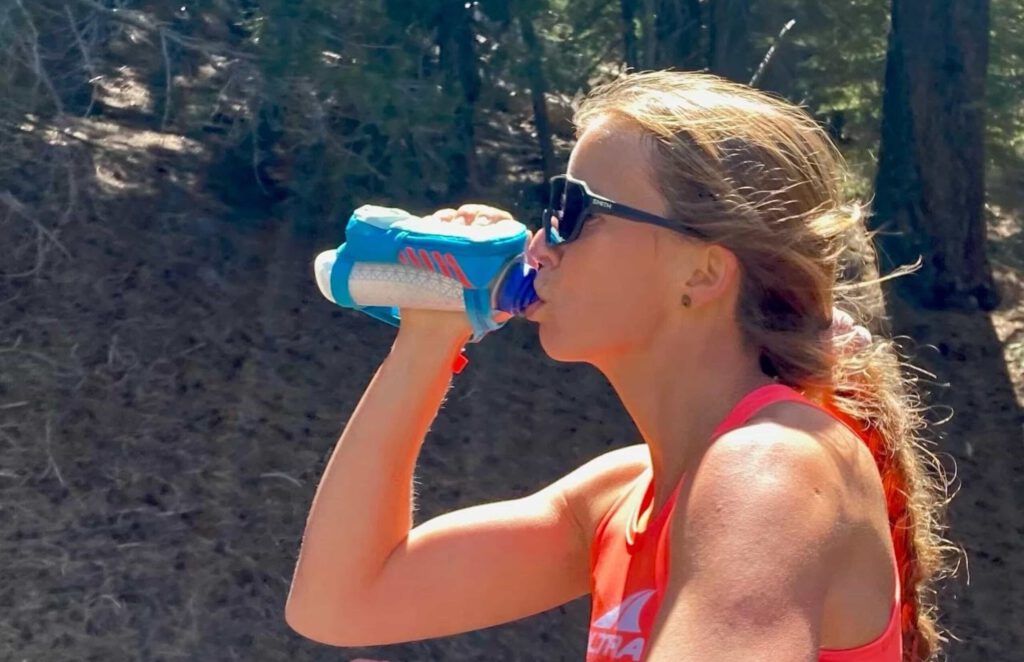Welcome to sweaty season! As the temperatures begin to rise and runs get longer, we are sure to be ending our runs in extra sweaty shorts and sports bras with salt crusts on our necks. While this transition from winter months to summer months may feel hard, our bodies are well equipped to deal with the heat.
We have evolved to sweat in response to an increase in body temperature (both core and skin) to dissipate heat (or cool down) during exercise.(7) We have sweat glands all over the body and the evaporative heat loss from these sweat glands is what keeps us cool during exercise and/or in hot environments.(7) Sweat typically is made up of water, sodium, potassium, and chloride, however during endurance exercise or in extremely hot environments, when sweat rates increase, the amount of salt excreted in the sweat may also increase.(7,2)
So what happens if I sweat a lot?
When exercise is prolonged, at higher intensities, and/or in a hot environment, the amount of sweat loss increases and can cause water and electrolyte imbalances.(2) Dehydration occurs when there is too little water in the body and can negatively impact our performance.(4) Dehydration can cause decreased cerebral and muscle blood flow and increased body temperature and heart rate.(4) These changes combined with decreases in mood can lead to increased discomfort and make exercising even harder. While the exact levels of dehydration vary per individual, it has been shown that decreases in body mass more than 2-4% negatively impacts performance metrics.(1) However, this number could be slightly higher in ultramarathon runners due to the nature of the sport.(2,3) Some studies in ultramarathoners have shown body mass losses of upwards of 14% or higher, which is high enough that could be extremely detrimental to performance.(3)
Drinking too much plain water, or overhydrating, can also be problematic for athletes and can lead to unnecessary bathroom stops, GI distress, or most importantly to a life-threatening condition called hyponatremia.(3) Hyponatremia occurs when sodium levels fall too low and causes water to move into the cells and cause swelling.(1) Symptoms of this extremely dangerous condition are lightheadedness, dizziness, weight gain, and puffiness.(1) This condition is prevalent in ultra-endurance events and should be taken seriously.(1) It is important to implement hydration strategies that account for both conditions during ultra-marathon events that can occur in extremely diverse environments.
So how do I hydrate for a long-run or race?
When it comes to hydrating, there is not a one-size fits all method. However, most athletes do not meet their hydration needs during long endurance events.(1) Sweat rates vary highly among athletes and vary with exercise intensity, environmental temperature, and exercise duration.(1) Sweat rates can range anywhere between .3L to 3L per hour, with most endurance athletes ranging between 500ml and 2L of sweat loss per hour (16.9– 50 ounces).(1) Sweat rate typically increases in extremely hot environments.(8)
Some runners successfully hydrate following their thirst response. Drinking to thirst may be sufficient for some during endurance events and events in cooler temperatures, however it may not be enough during long endurance events in high heat. Typically, long distance runners are not familiar enough with their sweat rates to determine accurate fluid intakes during long events.(6) A study looking at marathon runners found that un-planned drinking led to excessive dehydration. Therefore, a hydration plan may be advantageous in endurance events lasting longer than 90 minutes, in hot environments, and where consumption of carbohydrates is important.(5)
It may be advantageous for athletes with high sweat rates to determine their sweat rate before embarking on these types of endurance events/races. Sweat rates should be determined under conditions mimicking event and can be as simple as conducting a nude weight before/after activity. It is assumed by some that a loss of 1kg=1L of sweat loss.5 Individual sweat responses can then be used to build specific hydration plans.(4)

Rules of Hydration
So what does all of this mean? I just threw a lot of information at you. Summarized below are some hydration recommendations when toeing the line of an ultra-marathon or starting a long run:
Start the run or race in a hydrated state.
Do not start the run dehydrated. (3)
Make a hydration plan
When needed, implement a hydration plan during extremely vigorous or high-heat exercise environments especially if remembering to drink is difficult.(5)
Drink to thirst may suffice for shorter races in cooler temps.
Do not only drink plain water but supplement with electrolyte-containing beverages (3)
Use your sodium cravings as a determiner for additional sodium intake.(3)
Add carbohydrate to your electrolyte beverage to improve absorption of fluid in the gut during endurance activities >2 hours or in extreme heat. (8)
Keep hydrating consistently throughout the endurance event
600ml-1.2L per hour of fluid containing carbohydrates and sodium is recommended during long endurance events.(8)
Try to drink over the course of the hour and not all of the fluid at one time.
Pack enough fluids
Whether it’s a race or practice run, make sure you account for how much fluid you will need over the course of the run.
Plan out how much time you will take to get to each aid station or crew spot and carry enough water/electrolyte beverage between each.
Stash water containers along your route beforehand if you are running solo, or travel with a water filter if you are running routes with a lot of water crossings.
Practice, practice, practice!
Get used to your hydration needs in similar environments before the race or long-endurance event.
The “sweaty scaries” are here, but they don’t have to be scary anymore. Practice your hydration plan during your training runs so that come race day you can be scared about all the other scary parts of ultra- and trail-running, but not your hydration.
Citations:
- Armstrong LE. Rehydration during Endurance Exercise: Challenges, Research, Options, Methods. Nutrients. 13(3):887 (2021). doi: 10.3390/nu13030887. PMID: 33803421; PMCID: PMC8001428.
- Baker, Lindsay B. Sweating Rate and Sweat Sodium Concentration in Athletes: A Review of Methodology and Intra/Interindividual Variability. Sports medicine (Auckland, N.Z.) 47,1 (2017): 111-128. doi:10.1007/s40279-017-0691-5
- Hoffman, M., et al. Considerations for ultra-endurance activities: part 2 – hydration. Research in Sports Medicine. (2018). DOI: 10.1080/15438627.2018.1502189
- James, L.J., Funnell, M.P., James, R.M. et al. Does Hypohydration Really Impair Endurance Performance? Methodological Considerations for Interpreting Hydration Research. Sports Med 49, 103–114 (2019). https://doi.org/10.1007/s40279-019-01188-5
- Kenefick, R.W. Drinking Strategies: Planned Drinking Versus Drinking to Thirst. Sports Med 48. (2018) 31-37. https://doi.org/10.1007/s40279-017-0844-6
- O’Neal, Eric et al. Post-Exercise Sweat Loss Estimation Accuracy of Athletes and Physically Active Adults: A Review. Sports (Basel, Switzerland) 8,8 113. 11 (2020) 11 doi:10.3390/sports8080113
- Shibasaki, T. and Crandall, Greg. Neural control and mechanisms of eccrine sweating during heat stress and exercise Journal of Applied Physiology 100:5. (2006): 1692-1701
- Von Duvillard SP, Braun WA, Markofski M, Beneke R, Leithäuser R. Fluids and hydration in prolonged endurance performance. Nutrition.20(7-8) (2004): 651-6. doi: 10.1016/j.nut.2004.04.011. PMID: 15212747.
